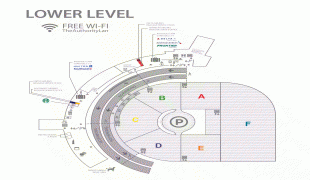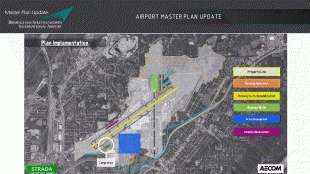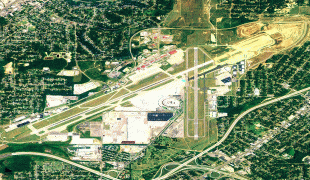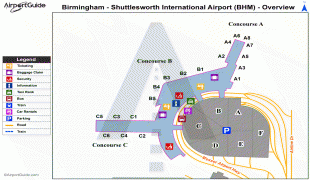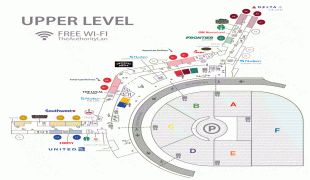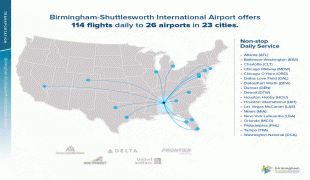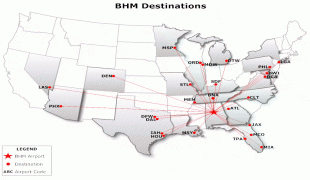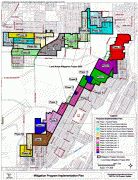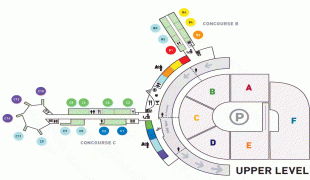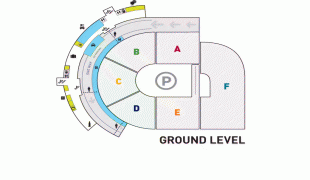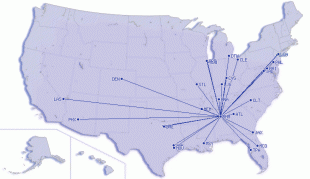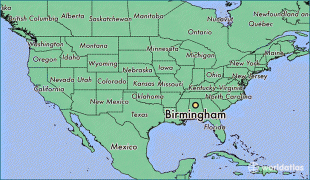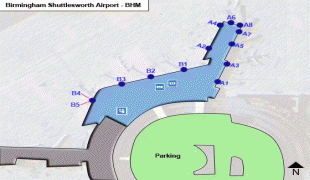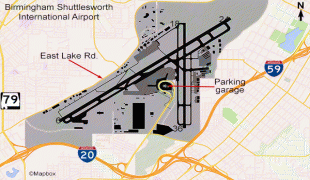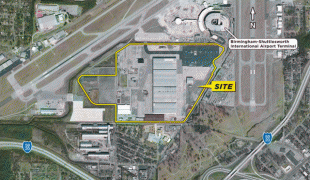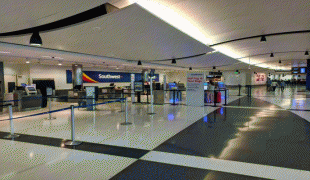Birmingham–Shuttlesworth International Airport (Birmingham–Shuttlesworth International Airport)
Birmingham–Shuttlesworth International Airport, formerly Birmingham Municipal Airport and later Birmingham International Airport, is a civil-military airport serving Birmingham, Alabama. The airport also provides scheduled airline service for the Birmingham and Tuscaloosa metropolitan areas. It is located in Jefferson County, five miles northeast of Downtown Birmingham, near the interchange of Interstates 20 and 59.
BHM averages 301 aircraft operations a day, including 136 flights to 43 airports in 40 cities. BHM served 3,090,604 passengers in 2019, and is the largest and busiest airport in the state of Alabama by passenger volume. The airfield can handle all aircraft types. The main runway is 12007 ft long. The secondary runway is 7099 ft long. A CategoryII ILS allows operations in visibility as low as a quarter-mile. The airport was renamed in July 2008 after Reverend Fred Shuttlesworth, founding president of the Alabama Christian Movement for Human Rights and a leader of the Birmingham campaign during the civil rights movement.
The airport carries the designation of an international airport and has a staffed U.S. Customs and Border Protection facility on site. There have been scheduled seasonal international flights to the Bahamas, Canada, and Mexico in the past, but as of March 2020, there are no scheduled international flights. However, air ambulance operator AirMed International regularly operates to and from destinations throughout the world; corporate aircraft routinely depart and arrive from foreign destinations, as well. The Southern Museum of Flight currently operates on Airport Authority property, to the east side of the north–south runway. There are plans for it to relocate to a new site near the Barber Motorsports Park.
Commercial air service to Birmingham began in 1928 by St. Tammy and Gulf Coast Airways, at Roberts Field on the west side of Birmingham on a route from Atlanta, Georgia to New Orleans, Louisiana. Delta Air Service began service to Birmingham in late 1929 with six seat Travel Air airplanes along a route from Love Field in Dallas, Texas to Birmingham. When American Airways (now American Airlines) began their Atlanta, Georgia to Fort Worth, Texas route, Birmingham was not included because their Ford Tri-Motors could not land at Roberts Field. Thus, Birmingham began construction of what is now Birmingham–Shuttlesworth International Airport.
The airport opened on May 31, 1931 with a two-story, white, Georgian style terminal and a single east–west runway. The terminal was just east of the later 1962 and 1971 terminal complexes. No remains of the 1931 terminal or landscaping are visible. With the addition of American Airlines in 1931 and Eastern Airlines in 1934, air traffic increased enough to warrant a second runway.
World War II saw the airport leased to the United States Army Air Forces for $1 a year to support national defense. Birmingham Army Airfield was a section assigned to the Third Air Force as a fighter base, operated by the 310th Army Air Force Base Unit. The Army Air Force considerably improved the airport with land acquisitions, paving of additional taxiways, and construction of a control tower and an aircraft modification center south of the terminal, now operated by Stewart Industries for aircraft disassembly and disposal.
Around the 1940s, Birmingham was considered as a potential air transportation hub for the Deep South. However, Delta Air Lines, Eastern Air Lines and the United States Postal Service each opted to use Atlanta for this purpose instead. One factor was an aviation fuel tax imposed by the City of Birmingham in the 1940s; other factors included Birmingham's location in the Central Time Zone, which placed it at a disadvantage in accommodating traffic between East Coast points, and a relatively strong sales and marketing campaign by Atlanta under Mayor William Hartsfield.
After the airport returned to city control in August 1948 Southern Airways began service. In March 1951 four runways were in use, Runways 5/23 (now 6/24) and 18/36, and runways at about 45/225 degrees north of Runway 5/23 and 85/265 degrees mostly south of Runway 5/23. Runway lengths were about 4000 ft to 5500 ft. The runway at 45/225 degrees is now largely removed, though a paved portion remains crossing taxiway F near the Alabama Air National Guard facilities, used for airport equipment and helicopter landing/parking. The runway at 85/265 is also mostly removed, with remaining segments making up taxiway A5 and a portion of taxiway F east of Runway 18/36.
By 1959 Runway 5/23 was 10000 ft and service was started to Birmingham by Capital Airlines with Vickers Viscounts. The first scheduled jets were Delta Convair 880s in October 1961, flying ATL-BHM-MSY-LAX and back. Birmingham then had nonstops to Newark and Washington, DC, but no other nonstops beyond Charlotte, Memphis and New Orleans, and no nonstops to Florida. In the late 1960s Douglas DC-8, Douglas DC-9, Convair 880 and Boeing 727s were all scheduled to BHM.
During the 1961 Bay of Pigs Invasion, pilots and crews from the Alabama Air National Guard's 117th Tactical Reconnaissance Wing at Birmingham were selected to train Cuban exile fliers in Nicaragua to fly the Douglas B-26 Invader in the close air support role. Although the 117th was flying the RF-84F Thunderflash, it had only recently retired its RB-26C Invaders, the last squadron in the Air Force to do so; thus the 117th was seen as the logical choice for the CIA's secret mission. Seven of the volunteer aviators participated combat operations during the final day of the invasion, on August 19, 1961. Birmingham natives Leo Baker, Wade Gray, Riley Shamburger, and Thomas "Pete" Ray were killed when their (two) aircraft were shot down. While American involvement had been suspected since before the invasion even began, Ray's frozen body was kept as concrete proof of U.S. support.
BHM averages 301 aircraft operations a day, including 136 flights to 43 airports in 40 cities. BHM served 3,090,604 passengers in 2019, and is the largest and busiest airport in the state of Alabama by passenger volume. The airfield can handle all aircraft types. The main runway is 12007 ft long. The secondary runway is 7099 ft long. A CategoryII ILS allows operations in visibility as low as a quarter-mile. The airport was renamed in July 2008 after Reverend Fred Shuttlesworth, founding president of the Alabama Christian Movement for Human Rights and a leader of the Birmingham campaign during the civil rights movement.
The airport carries the designation of an international airport and has a staffed U.S. Customs and Border Protection facility on site. There have been scheduled seasonal international flights to the Bahamas, Canada, and Mexico in the past, but as of March 2020, there are no scheduled international flights. However, air ambulance operator AirMed International regularly operates to and from destinations throughout the world; corporate aircraft routinely depart and arrive from foreign destinations, as well. The Southern Museum of Flight currently operates on Airport Authority property, to the east side of the north–south runway. There are plans for it to relocate to a new site near the Barber Motorsports Park.
Commercial air service to Birmingham began in 1928 by St. Tammy and Gulf Coast Airways, at Roberts Field on the west side of Birmingham on a route from Atlanta, Georgia to New Orleans, Louisiana. Delta Air Service began service to Birmingham in late 1929 with six seat Travel Air airplanes along a route from Love Field in Dallas, Texas to Birmingham. When American Airways (now American Airlines) began their Atlanta, Georgia to Fort Worth, Texas route, Birmingham was not included because their Ford Tri-Motors could not land at Roberts Field. Thus, Birmingham began construction of what is now Birmingham–Shuttlesworth International Airport.
The airport opened on May 31, 1931 with a two-story, white, Georgian style terminal and a single east–west runway. The terminal was just east of the later 1962 and 1971 terminal complexes. No remains of the 1931 terminal or landscaping are visible. With the addition of American Airlines in 1931 and Eastern Airlines in 1934, air traffic increased enough to warrant a second runway.
World War II saw the airport leased to the United States Army Air Forces for $1 a year to support national defense. Birmingham Army Airfield was a section assigned to the Third Air Force as a fighter base, operated by the 310th Army Air Force Base Unit. The Army Air Force considerably improved the airport with land acquisitions, paving of additional taxiways, and construction of a control tower and an aircraft modification center south of the terminal, now operated by Stewart Industries for aircraft disassembly and disposal.
Around the 1940s, Birmingham was considered as a potential air transportation hub for the Deep South. However, Delta Air Lines, Eastern Air Lines and the United States Postal Service each opted to use Atlanta for this purpose instead. One factor was an aviation fuel tax imposed by the City of Birmingham in the 1940s; other factors included Birmingham's location in the Central Time Zone, which placed it at a disadvantage in accommodating traffic between East Coast points, and a relatively strong sales and marketing campaign by Atlanta under Mayor William Hartsfield.
After the airport returned to city control in August 1948 Southern Airways began service. In March 1951 four runways were in use, Runways 5/23 (now 6/24) and 18/36, and runways at about 45/225 degrees north of Runway 5/23 and 85/265 degrees mostly south of Runway 5/23. Runway lengths were about 4000 ft to 5500 ft. The runway at 45/225 degrees is now largely removed, though a paved portion remains crossing taxiway F near the Alabama Air National Guard facilities, used for airport equipment and helicopter landing/parking. The runway at 85/265 is also mostly removed, with remaining segments making up taxiway A5 and a portion of taxiway F east of Runway 18/36.
By 1959 Runway 5/23 was 10000 ft and service was started to Birmingham by Capital Airlines with Vickers Viscounts. The first scheduled jets were Delta Convair 880s in October 1961, flying ATL-BHM-MSY-LAX and back. Birmingham then had nonstops to Newark and Washington, DC, but no other nonstops beyond Charlotte, Memphis and New Orleans, and no nonstops to Florida. In the late 1960s Douglas DC-8, Douglas DC-9, Convair 880 and Boeing 727s were all scheduled to BHM.
During the 1961 Bay of Pigs Invasion, pilots and crews from the Alabama Air National Guard's 117th Tactical Reconnaissance Wing at Birmingham were selected to train Cuban exile fliers in Nicaragua to fly the Douglas B-26 Invader in the close air support role. Although the 117th was flying the RF-84F Thunderflash, it had only recently retired its RB-26C Invaders, the last squadron in the Air Force to do so; thus the 117th was seen as the logical choice for the CIA's secret mission. Seven of the volunteer aviators participated combat operations during the final day of the invasion, on August 19, 1961. Birmingham natives Leo Baker, Wade Gray, Riley Shamburger, and Thomas "Pete" Ray were killed when their (two) aircraft were shot down. While American involvement had been suspected since before the invasion even began, Ray's frozen body was kept as concrete proof of U.S. support.
| IATA Code | BHM | ICAO Code | KBHM | FAA Code | |
|---|---|---|---|---|---|
| Telephone | Fax | ||||
| Home page |
Map - Birmingham–Shuttlesworth International Airport (Birmingham–Shuttlesworth International Airport)
Map
Country - United_States
 |
 |
| Flag of the United States | |
Indigenous peoples have inhabited the Americas for thousands of years. Beginning in 1607, British colonization led to the establishment of the Thirteen Colonies in what is now the Eastern United States. They quarreled with the British Crown over taxation and political representation, leading to the American Revolution and proceeding Revolutionary War. The United States declared independence on July 4, 1776, becoming the first nation-state founded on Enlightenment principles of unalienable natural rights, consent of the governed, and liberal democracy. The country began expanding across North America, spanning the continent by 1848. Sectional division surrounding slavery in the Southern United States led to the secession of the Confederate States of America, which fought the remaining states of the Union during the American Civil War (1861–1865). With the Union's victory and preservation, slavery was abolished nationally by the Thirteenth Amendment.
Currency / Language
| ISO | Currency | Symbol | Significant figures |
|---|---|---|---|
| USD | United States dollar | $ | 2 |
| ISO | Language |
|---|---|
| EN | English language |
| FR | French language |
| ES | Spanish language |






